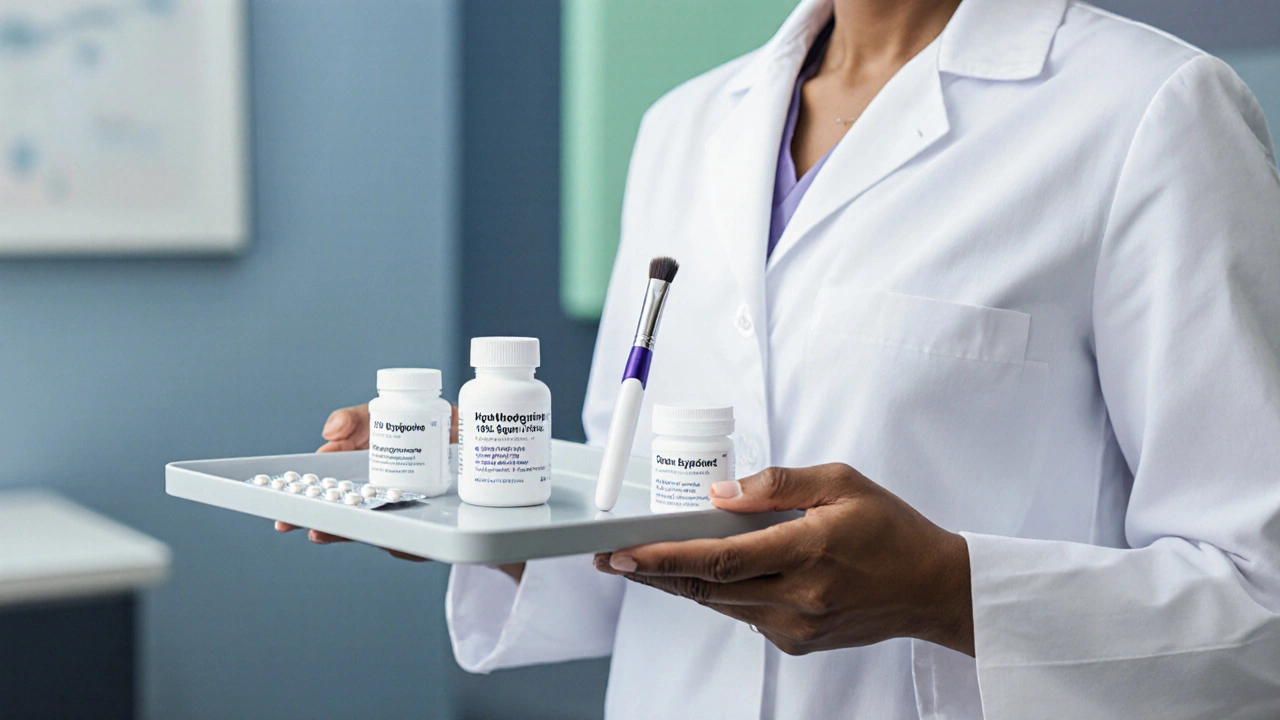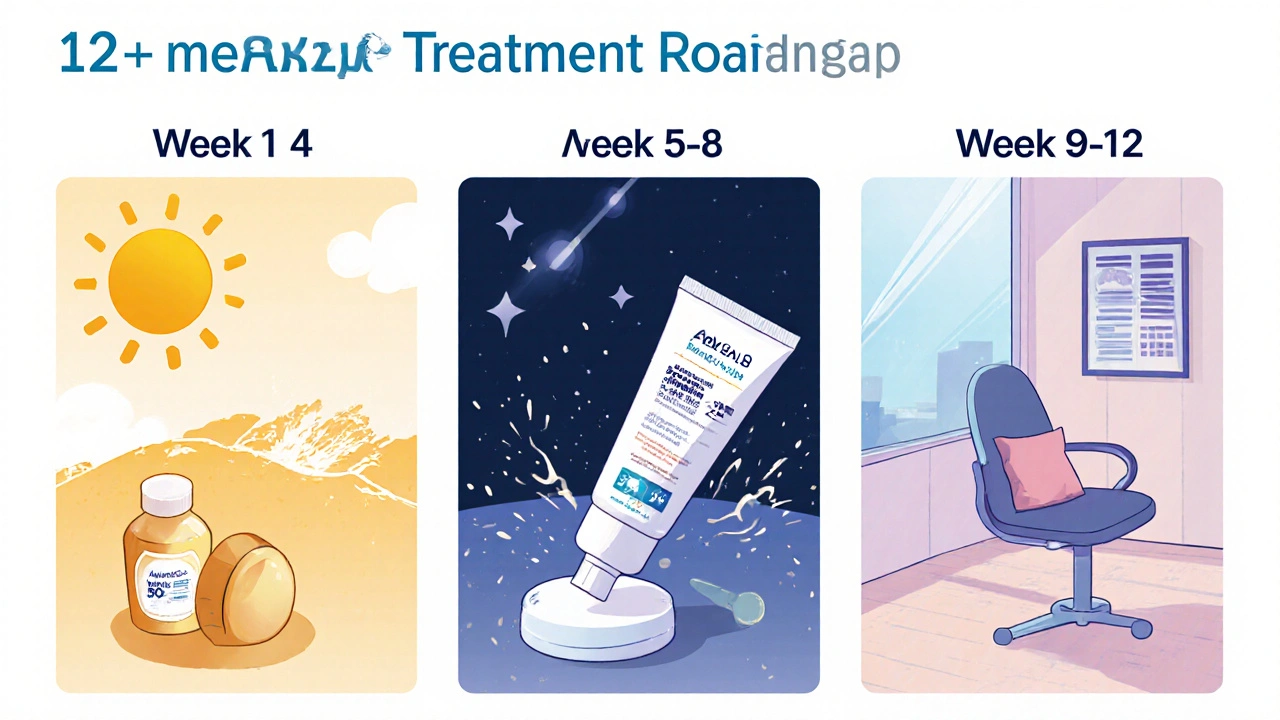Melasma Treatment Selector for Skin of Color
This tool helps you identify the most appropriate melasma treatments for your skin type and situation based on clinical evidence. Select your preferences to receive personalized recommendations that align with the article's guidance on treating melasma in skin of color.
Select your preferences and click the button above to see personalized recommendations.
If you’ve ever struggled with stubborn brown patches that refuse to fade, you know how frustrating melasma can be, especially when you have melasma skin of color. This condition behaves differently on darker tones, often leaving a deeper, more uneven hue that standard creams don’t touch. Below you’ll find a clear roadmap to understand why melasma acts the way it does on pigmented skin and which treatments actually move the needle.
Understanding Melasma in Skin of Color
Melasma is a chronic hyperpigmentation disorder that appears as irregular, brown‑gray patches, usually on the face. It thrives on hormonal shifts, UV exposure, and genetic predisposition. While anyone can develop melasma, people with higher melanin levels-often referred to as Skin of Color-experience a more intense coloration because the excess melanin is produced in larger, more reactive clusters.
The condition is not merely cosmetic; it can affect self‑esteem and trigger a constant search for the next “miracle” product. Recognizing the underlying mechanisms-like the role of the Fitzpatrick Scale in assessing UV sensitivity-helps tailor a plan that respects the unique biology of darker skin.
Why Standard Treatments Often Fall Short
Many over‑the‑counter brighteners were formulated with lighter skin in mind. Ingredients such as high‑dose hydroquinone can cause irritation, post‑inflammatory hyperpigmentation, or even a paradoxical darkening in melanin‑rich skin. Moreover, the barrier function of darker epidermis tends to be tighter, meaning some actives cannot penetrate deep enough to reach the melanocytes that produce the excess pigment.
Another hidden factor is the uneven distribution of melanin granules. In Skin of Color, melanin tends to cluster in larger, more stable units, making it harder for topical agents to break them down. As a result, you often need a combination approach-targeting melanin production, encouraging melanin removal, and preventing new pigment from forming.
Tailored Treatment Options
Below is a quick‑look comparison of the most reliable options for melasma on darker tones. Each treatment has specific attributes, efficacy ratings, and safety considerations.
| Ingredient / Modality | How It Works | Typical Concentration for Darker Skin | Strengths | Potential Drawbacks |
|---|---|---|---|---|
| Hydroquinone (a phenolic bleaching agent) | Inhibits tyrosinase, the enzyme that drives melanin synthesis. | 2‑4% (lower than the 4‑6% often used for lighter skin) | Fast‑acting, well‑studied. | Can cause irritation, ochronosis (darkening) with prolonged use. |
| Azelaic Acid (dicarboxylic acid) | Blocks tyrosinase & reduces abnormal keratinization. | 15‑20% gel or cream. | Gentle, anti‑inflammatory; also helps acne‑prone skin. | Potential mild tingling; slower results. |
| Tranexamic Acid (oral or topical antifibrinolytic) | Reduces UV‑induced plasmin activity, decreasing melanin transfer. | Topical 2‑5% or oral 250 mg twice daily (under doctor supervision). | Effective for stubborn melasma; low irritation. | Requires prescription; oral use may affect clotting. |
| Chemical Peels (glycolic, lactic, or TCA) | Exfoliates the stratum corneum, shedding pigmented cells. | Superficial 20‑30% glycolic or 30‑40% lactic peel. | Can improve texture and tone simultaneously. | Risk of post‑inflammatory hyperpigmentation if too deep. |
| Laser Therapy (Q‑switched Nd:YAG 1064 nm) | Targets melanin particles with high‑energy pulses. | Low fluence, multiple sessions. | Precise, fast results for focal patches. | Potential rebound hyperpigmentation; needs skilled operator. |
When you combine two or more modalities-say, a low‑dose hydroquinone with nightly azelaic acid and diligent sun protection-you strike at melasma from several angles, which is crucial for darker skin where pigment is more stubborn.

Sun Protection: The Non‑Negotiable Step
Even the most powerful creams won’t hold back new pigment if UV rays keep flooding the skin. For Skin of Color, many think sunscreen isn’t needed because they “don’t burn,” but melasma is driven primarily by UVA, which penetrates clouds and glass. A broad‑spectrum SPF 30‑50 sunscreen that contains zinc oxide or titanium dioxide offers physical blockage without adding chemical irritants.
Apply a generous pea‑size amount for the face, and reapply every two hours when outdoors. Pair sunscreen with physical barriers-wide‑brim hats, UPF clothing, and sunglasses-to minimize cumulative exposure.
Lifestyle and Hormonal Factors
Hormones are the silent engines behind melasma. Pregnancy, oral contraceptives, and hormone replacement therapy can spike estrogen and progesterone, prompting melanocytes to go into overdrive. If you’re on hormonal meds, discuss dose adjustments or alternative birth control methods with your dermatologist.
Other lifestyle triggers include:
- Stress: Cortisol can indirectly affect melanin production.
- Skincare routines that over‑exfoliate: Damaging the barrier fuels inflammation, leading to more pigment.
- Diet: While evidence is limited, foods rich in antioxidants (berries, green tea) may support skin health.

Working with a Dermatologist
Because melasma in Skin of Color is a nuanced condition, a board‑certified dermatologist who understands ethnic skin is essential. Look for professionals who list “pigmentation disorders in darker skin” as a specialty. They can prescribe oral tranexamic acid, tailor laser settings, and monitor for adverse effects.
During your visit, bring a “pigmentation diary” with photos, product lists, and any hormonal changes you’ve experienced. This data helps the clinician map triggers and adjust your regimen quickly.
Common Pitfalls & How to Avoid Them
Even with the right plan, many patients stumble on avoidable mistakes:
- Using too‑strong hydroquinone. Stick to 2‑4% for darker skin and limit use to three months before taking a break.
- Skipping sunscreen on cloudy days. UVA rays are constant; sunscreen is a daily habit.
- Mixing irritating actives. Pairing retinoids with high‑strength acids can flare inflammation. Schedule them at different times of day.
- Expecting overnight miracles. Melasma fades gradually-typically 2‑6 months of consistent therapy.
- Choosing “one‑size‑fits‑all” treatments. Each skin tone reacts uniquely; personalize your approach.
By staying vigilant, you’ll keep progress steady and avoid the dreaded rebound darkening.
Putting It All Together: A Sample 12‑Week Plan
Here’s a practical roadmap you can discuss with your dermatologist. Adjust concentrations and timelines based on your comfort level.
- Weeks 1‑4: Morning - SPF 50 sunscreen + 15% azelaic acid cream. Evening - 2% hydroquinone cream (alternating nights with a gentle moisturizer).
- Weeks 5‑8: Add oral tranexamic acid 250 mg twice daily (if cleared by doctor). Continue azelaic acid and sunscreen.
- Weeks 9‑12: Schedule a superficial glycolic peel (20%) at a certified clinic. Maintain topical regimen; evaluate progress with photos.
After 12 weeks, assess pigment reduction. If results plateau, consider low‑fluence Q‑switched Nd:YAG laser sessions spaced six weeks apart.
Can melasma disappear on its own?
Melasma rarely resolves without treatment. Hormonal shifts may lessen intensity temporarily, but the pigment usually returns once triggers reappear.
Is hydroquinone safe for dark skin?
When used at 2‑4% under dermatologist supervision, hydroquinone is safe for Skin of Color. Higher concentrations or prolonged use increase the risk of ochronosis.
How often should I reapply sunscreen?
Reapply every two hours outdoors and immediately after sweating or towel‑drying. On cloudy days, still apply a thin layer each morning.
Can dietary changes affect melasma?
While diet alone won’t cure melasma, antioxidants (vitamin C, green tea polyphenols) support skin health and may reduce inflammation that worsens pigmentation.
Is laser treatment safe for darker skin tones?
Yes, but only when performed by a clinician experienced with the Q‑switched Nd:YAG 1064 nm laser. This wavelength penetrates deeper without targeting melanin in the epidermis, lowering the risk of post‑inflammatory hyperpigmentation.






Zachary Blackwell
October 23, 2025 AT 12:53Yo, you ever notice how the big pharma and sunscreen giants push these 30‑50 SPF creams like they're the holy grail? They scream "UVA is dangerous" while conveniently ignoring that most of us with melasma just need smarter, not stronger, actives. The whole industry loves to keep us buying endless bottles, hoping we’ll never figure out that a simple zinc‑oxide mix does the trick without the drama. Plus, those laser clinics? Mostly a cash‑cow for a few shady docs who love the hype. Stay woke, and don’t let the hype train run you over.
prithi mallick
November 1, 2025 AT 05:53i totally get how disheartening melasma can be, especially when you feel like every product just makes it worse. try to keep a positive mindset and remember that consistency is key-don’t abandon a regimen after a couple of weeks. also, keep a journal of what you use and any changes in your skin, it helps your dermatologist see patterns. stay strong, you got this!
Michaela Dixon
November 9, 2025 AT 23:53Alright, let’s break down the full 12‑week protocol and why each step matters, because a piecemeal approach just won’t cut it for melasma on deeper skin tones.
First, the mornings start with a broad‑spectrum SPF 50 that contains zinc oxide – this physical barrier is non‑irritating and reflects both UVA and UVB, which is crucial since UVA is the primary driver of pigment in darker skin.
Next, you layer a 15% azelaic acid cream; azelaic not only inhibits tyrosinase but also calms inflammation, which is a double win for hyperpigmentation and any underlying acne‑like lesions.
In the evenings, a 2% hydroquinone cream is applied on alternate nights; the lower concentration reduces the risk of irritation while still providing a measurable melanin‑suppressing effect.
Between hydroquinone nights, you use a gentle, ceramide‑rich moisturizer to reinforce the skin barrier and prevent the post‑inflammatory hyperpigmentation that can flare up when the barrier is compromised.
Weeks five through eight introduce oral tranexamic acid at 250 mg twice daily, but only under a dermatologist’s supervision, because it curtails the UV‑induced plasmin pathway that otherwise shuttles melanin to the epidermis.
During this phase, you continue the azelaic and sunscreen regimen steadfastly, because consistency prevents the rebound effect you often see when patients stop abruptly.
In weeks nine to twelve, you schedule a superficial glycolic peel (20%) at a certified clinic; the controlled exfoliation gently removes the pigmented stratum corneum without triggering the deeper PIH that a too‑deep peel would cause.
After the peel, you resume the nightly hydroquinone and azelaic routine, but you also add a short course of a low‑fluence Q‑switched Nd:YAG laser if the pigment plateaus – this laser specifically targets melanin particles in the dermis without overheating the epidermis, which is safer for skin of color.
Throughout the entire plan, you keep a daily “pigmentation diary” with photos and notes on hormonal fluctuations, stress levels, and any new skincare products – this data is gold for your dermatologist to tweak dosages or add adjuncts like topical tranexamic acid if needed.
Don’t forget lifestyle tweaks: wear a wide‑brim hat, limit direct sun exposure during peak hours, and incorporate antioxidant‑rich foods like berries and green tea, which help mitigate oxidative stress that fuels melanin production.
Remember, melasma is a chronic condition; even after you see improvement, maintenance with sunscreen, azelaic acid, and occasional low‑dose hydroquinone is essential to keep the pigment at bay.
Patience is key – most patients notice visible lightening after 2‑3 months, but full stabilization can take up to six months of diligent care.
Finally, always consult a board‑certified dermatologist experienced with ethnic skin before starting high‑potency actives or oral agents, because missteps can lead to the dreaded ochronosis or rebound hyperpigmentation.
Dan Danuts
November 18, 2025 AT 17:53Wow, that was an epic rundown! I love how you laid everything out step‑by‑step – makes it way less intimidating. Sticking to the routine might be tough, but having that clear roadmap will keep us motivated. Keep crushing it, everyone!
Dante Russello
November 27, 2025 AT 11:53Interesting points, Zach. While I’m skeptical of some of the conspiracy angles, I do agree that sunscreen choice matters. A mineral SPF with zinc oxide is a solid, low‑irritant option for melasma‑prone skin. Balance is key.
James Gray
December 6, 2025 AT 05:53Just grab a good mineral sunscreen and keep it on.
Danielle St. Marie
December 14, 2025 AT 23:53Honestly, if you can’t handle a little melasma, maybe you’re not cut out for the real world 😒. These "miracle" treatments are for people who think a quick fix solves everything. Get over it.
keerthi yeligay
December 23, 2025 AT 17:53i’m sorry but melasma is a legit condition and many people suffer from it . it’s not a sign of weakness and seeking help is brave .